
The Legion of Merit (LOM) is a military award of the United States Armed Forces that is given for exceptionally meritorious conduct in the performance of outstanding services and achievements. The decoration is issued to members of the eight uniformed services of the United States as well as to military and political figures of foreign governments.

The Defense Meritorious Service Medal (DMSM) is an award bestowed upon members of the United States military by the United States Department of Defense. In the order of precedence of the United States Armed Forces, it is worn between the Purple Heart and the Meritorious Service Medal. The medal is awarded in the name of the Secretary of Defense to members of the Armed Forces who, while serving in a joint activity, distinguish themselves by non-combat outstanding achievement or meritorious service, but not of a degree to warrant award of the Defense Superior Service Medal.

The Republic of Vietnam Campaign Medal, also known as the Vietnam Campaign Medal, is a South Vietnamese military campaign medal which was created in 1949, and awarded to French military personnel during the First Indochina War. During the Vietnam War, the South Vietnamese government awarded the Republic of Vietnam Campaign Medal with Device to members of the South Vietnamese military for wartime service and on March 24, 1966, to members of the U.S. military for support of operations in Vietnam. In May 1966, other allied foreign military personnel became eligible for the award.

The Order of Orange-Nassau is a civil and military Dutch order of chivalry founded on 4 April 1892 by the Queen regent Emma, acting on behalf of her under-age daughter Queen Wilhelmina.

The Queen Elizabeth II Silver Jubilee Medal was a commemorative medal created in 1977 to mark the twenty-fifth anniversary of Elizabeth II's accession in the United Kingdom, Canada, Australia, and New Zealand. The medal was physically identical in all realms where it was awarded, save for Canada, where it contained unique elements. As an internationally distributed award, the Queen Elizabeth II Silver Jubilee Medal holds a different place in each country's order of precedence for honours.
The Royal Victorian Medal (RVM) is a decoration established by Queen Victoria in April 1896. On 14 May 1912, King George V further confirmed the institution of the medal with an additional royal warrant. A part of the Royal Victorian Order, it is a reward for personal service to the Sovereign or the royal family, and is the personal gift of the sovereign. It differs from other grades of the order in appearance and in the way it is worn.
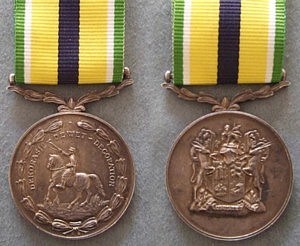
The De Wet Decoration, post-nominal letters DWD, is a military long service decoration which was instituted by the Republic of South Africa in 1965. It could be awarded to members of the Commandos, the rural civil defence component of the South African Defence Force, for twenty years of efficient service and good conduct. The decoration was initially reserved for officers, but it was made available to all ranks in 1986. A clasp could be awarded after thirty years service.
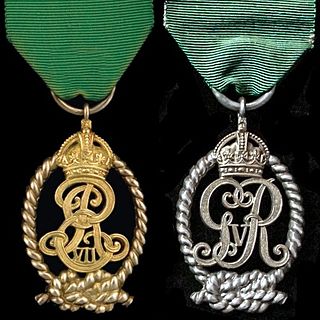
The Decoration for Officers of the Royal Naval Volunteer Reserve, post-nominal letters VD until c. 1947 and VRD thereafter, was instituted in 1908. It could be awarded to part-time commissioned officers in the United Kingdom's Royal Naval Volunteer Reserve after twenty years of service as efficient and thoroughly capable officers. The decoration was a Naval version of the Volunteer Officers' Decoration and its successor, the Territorial Decoration.
The Military Cross is a military long service decoration of Belgium. It was established by Royal Decree on 11 February 1885 and is awarded to commissioned officers in the Belgian Armed Forces for loyal and uninterrupted service or to Non-Belgian military officers for distinguished service in favor of the Military of Belgium.

The Medal For Faithful Service in the National People’s Army was a medal issued in the German Democratic Republic (GDR).

The Efficiency Decoration, post-nominal letters TD for recipients serving in the Territorial Army of the United Kingdom or ED for those serving in the Auxiliary Military Forces, was instituted in 1930 for award to part-time officers after twenty years of service as an efficient and thoroughly capable officer. The decoration superseded the Volunteer Officers' Decoration, the Colonial Auxiliary Forces Officers' Decoration and the Territorial Decoration.

The Service Medal of the Order of St John is awarded to recognise both conspicuous and long service with the Venerable Order of St John, particularly in St John Ambulance, both in the United Kingdom and in a number of other Commonwealth countries. The award was announced in the St John Ambulance Brigade General Regulations for 1895 and minted in 1899, though the first honourees had been selected the previous year.

The Efficiency Decoration , post-nominal letters ED, was instituted in 1930 for award to efficient and thoroughly capable part-time officers in the Citizen Force of the Union of South Africa after twenty years of service. The decoration superseded the Colonial Auxiliary Forces Officers' Decoration.
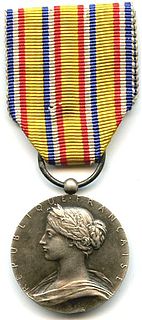
The Honour medal for firefighters is a state decoration of France bestowed by the Ministry of the Interior to members of the French Fire Service.

The Medal for voluntary military service is a French military decoration established on 13 March 1975 by decree 75-150. It was established in three grades to recognize voluntary military service in the reserves.

The Abyssinian War Medal was awarded for service between 4 October 1867 and 19 April 1868 to those who participated in the 1868 Expedition to Abyssinia. This punitive expedition, led by Lieutenant-General Sir Robert Napier, was carried out by the armed forces of the British Empire against the Ethiopian Empire. Emperor Tewodros II of Ethiopia imprisoned several missionaries and two representatives of the British government. The punitive expedition launched by the British in response required transporting a sizable military force hundreds of miles across mountainous terrain lacking any road system.
The Croix de guerre (French) or Oorlogskruis (Dutch), both literally translating as "Cross of War", is a military decoration of the Kingdom of Belgium established by royal decree on 25 October 1915. It was primarily awarded for bravery or other military virtue on the battlefield. The award was reestablished on 20 July 1940 by the Belgian government in exile for recognition of bravery and military virtue during World War II. The post-1940 decoration could also be awarded to units that were cited. The decoration was again reestablished by royal decree on 3 April 1954 for award during future conflicts.
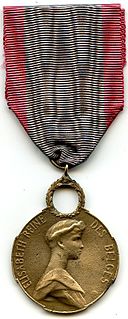
The Queen Elisabeth Medal was a Belgian decoration created by royal decree in October 1916 to recognise exceptional services to Belgium in the relief of the suffering of its citizens during the First World War. Its statute was ratified on 14 May 1919. It was awarded to people, both Belgians and foreign nationals, who, like Queen Elisabeth herself, had worked and cared for the suffering victims of war for a year or more prior to 10 September 1919. Although not limited to medical care of the sick and wounded, recipients who earned the medal by working in hospitals received a variant with a red enamelled cross within the suspension wreath. A great many Belgian and foreign doctors and nurses received the medal.
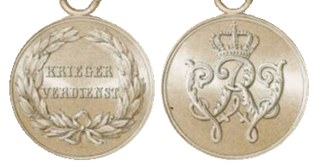
Military decoration of Prussian Army

The Honour medal of railroads is a state decoration bestowed by the French Republic in the form of an honour medal for work. It was originally meant to reward, depending on the quality and length of time calculated in calendar years, the services rendered by French agents and labourers and to nationals of the French Union or protectorates, in service with the railroads. The Honour medal of railroads was created by decree on 19 August 1913 as a reward for thirty years of service. Since then, many modifications were instituted by consecutive decrees amending the original text.
















